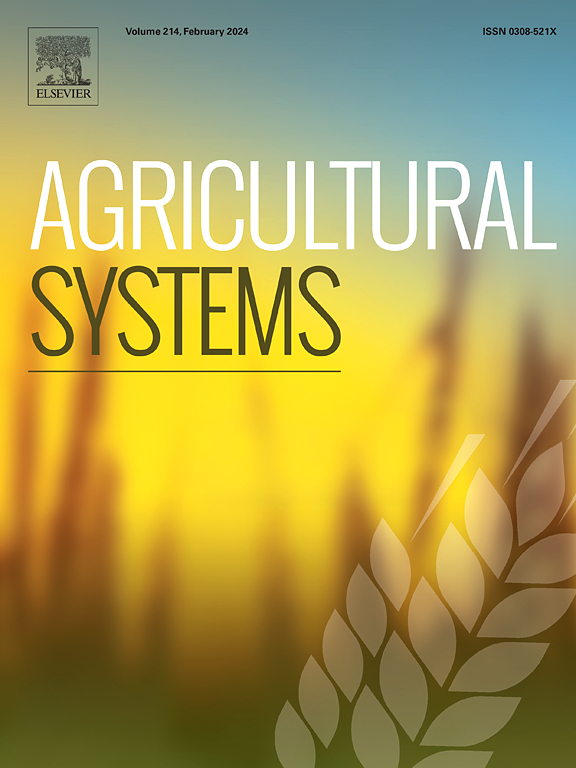Climate warming enhances sugarcane yield and increases annual harvest frequency in northern coastal New South Wales, Australia
IF 6.1
1区 农林科学
Q1 AGRICULTURE, MULTIDISCIPLINARY
引用次数: 0
Abstract
CONTEXT
Australia is a leading exporter of raw sugar on the global market. Rising temperatures could enable sugarcane to achieve harvestable yields in a 1-year growth cycle instead of the traditional 2-year cycle in the subtropical regions of northern New South Wales (NSW). However, no study has evaluated how climate change impacts annual harvest frequency, leaving a critical gap in understanding sugarcane production's future in Australia.
OBJECTIVE
We aim to quantify the impacts of climate change on sugarcane yield and annual harvest frequency and identify the main climatic drivers that determine yield change.
METHODS
We used sugarcane yield data collected from three milling regions, Condong, Broadwater, and Harwood, to validate the QCANE sugarcane model in northern coastal NSW. The validated model was then driven by climate data downscaled from 27 global climate models under the Coupled Model Intercomparison Project Phase 6 to simulate sugarcane growth and sugar accumulations.
RESULTS AND CONCLUSIONS
The QCANE model showed strong agreement between simulated and observed values, with an R2 of 0.83 for stalk fresh weight (FW) and 0.80 for sucrose weight (SW), and nRMSE values of 9.4 % for FW and 10.0 % for SW. Under rising emissions (SSP126 to SSP585), yield projections indicated increases by the end of the 21st century, with FW rising by 6–34 Mg ha−1 (i.e., 6–29 %), biomass dry weight (DW) by 2–11 Mg ha−1 (6–29 %), and SW by 1–7 Mg ha−1 (10–46 %) across the three study sites. Additionally, the annual harvest frequency was expected to increase from 50 to 80 % during the baseline period (1981–2020) to 68–96 %, with a greater proportion of future years supporting frequent annual harvests. Climate variables accounted for 93–96 % of the yield variation, with elevated atmospheric CO2 concentration as the dominant contributor to yield increases.
SIGNIFICANCE
These findings highlight opportunities to enhance sugarcane production by adopting a 1-year harvest cycle under future climate conditions, providing valuable insights for the sugarcane industry to adapt and thrive in the face of climate change.

气候变暖提高了澳大利亚新南威尔士州北部沿海地区的甘蔗产量,增加了每年的收获频率
澳大利亚是全球市场上主要的原糖出口国。在新南威尔士州北部的亚热带地区,气温上升可以使甘蔗在1年的生长周期内获得可收获的产量,而不是传统的2年周期。然而,没有研究评估过气候变化如何影响年度收获频率,这在了解澳大利亚甘蔗生产的未来方面留下了一个关键的空白。目的量化气候变化对甘蔗产量和年收获频率的影响,确定影响产量变化的主要气候驱动因素。方法利用Condong、Broadwater和Harwood三个甘蔗产区的甘蔗产量数据,验证了QCANE甘蔗模型在新南威尔士州北部沿海地区的应用。然后,利用耦合模式比对项目第6阶段的27个全球气候模式的气候数据来模拟甘蔗生长和糖积累。结果与结论QCANE模型的模拟值与实测值吻合较好,秸秆鲜重(FW)和蔗糖重(SW)的R2分别为0.83和0.80,FW和SW的nRMSE分别为9.4%和10.0%。在排放增加的情况下(SSP126至SSP585),产量预测显示,到21世纪末,三个研究地点的FW增加6-34 Mg ha - 1(即6 - 29%),生物量干重(DW)增加2-11 Mg ha - 1 (6 - 29%), SW增加1 - 7 Mg ha - 1(10 - 46%)。此外,年收获频率预计将从基准期(1981-2020年)的50% - 80%增加到68% - 96%,未来年份支持频繁年收获的比例将更大。气候变量占产量变化的93 - 96%,其中大气CO2浓度升高是产量增加的主要因素。这些发现强调了在未来气候条件下通过采用1年收获周期来提高甘蔗产量的机会,为甘蔗产业在气候变化面前适应和繁荣提供了有价值的见解。
本文章由计算机程序翻译,如有差异,请以英文原文为准。
求助全文
约1分钟内获得全文
求助全文
来源期刊

Agricultural Systems
农林科学-农业综合
CiteScore
13.30
自引率
7.60%
发文量
174
审稿时长
30 days
期刊介绍:
Agricultural Systems is an international journal that deals with interactions - among the components of agricultural systems, among hierarchical levels of agricultural systems, between agricultural and other land use systems, and between agricultural systems and their natural, social and economic environments.
The scope includes the development and application of systems analysis methodologies in the following areas:
Systems approaches in the sustainable intensification of agriculture; pathways for sustainable intensification; crop-livestock integration; farm-level resource allocation; quantification of benefits and trade-offs at farm to landscape levels; integrative, participatory and dynamic modelling approaches for qualitative and quantitative assessments of agricultural systems and decision making;
The interactions between agricultural and non-agricultural landscapes; the multiple services of agricultural systems; food security and the environment;
Global change and adaptation science; transformational adaptations as driven by changes in climate, policy, values and attitudes influencing the design of farming systems;
Development and application of farming systems design tools and methods for impact, scenario and case study analysis; managing the complexities of dynamic agricultural systems; innovation systems and multi stakeholder arrangements that support or promote change and (or) inform policy decisions.
 求助内容:
求助内容: 应助结果提醒方式:
应助结果提醒方式:


